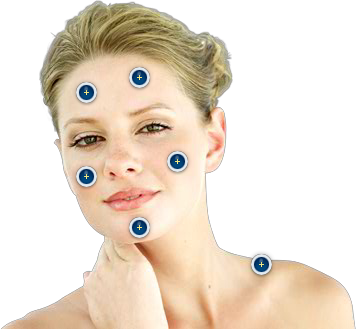Types Of Acne
Product Information
Types of Acne

Types of Acne
Acne is a common term used to describes all types of skin lesions. There are medical terms to describes the different types of acne. Here they are:
Types of Acne #1: Acne Vulgaris
Acne vulgaris is the medical term for the common acne. This is the type of acne that affects mainly teenagers.
Mild to severe acne vulgaris is characterized by the following lesions:
Types of acne #2: Whiteheads
Whiteheads is where the pores of the skin is completely blocked. It traps the sebum (oil) and dead skin cells. The sebum appears white on the skin as it is totally under the skin. This is why it is called whiteheads. They do have a shorter life span than blackheads. It is considered a mild form of acne vulgaris.
Types of acne #3: Blackheads (Comedones)
Blackheads are similar to whiteheads. Them main difference is that it has a black appearance on the skin. This is caused by partially blocked pores where the sebum, bacteria and dead skin cells are exposed to air. It is the air (oxidation) reacting with the skin’s pigment, melanin, that causes the dark color. Most people think it’s dirt trapped in the pores. That is not the case. The other difference between blackheads and whiteheads is that blackheads take longer to clear. Similar to whiteheads, blackheads are considered to be a mild form of acne vulgaris.
Types of acne #4: Papules
Papules are red, inflamed, bumps with no head. You may feel an itchy sensation. Papules can be considered as a moderate form of acne.
Types of acne #5: Pustules
Postules appears as inflamed, red circles. The center appears yellow or white. Teenagers call this a “zit” as you can feel the head of the inflamed area. It looks like it’s about to burst.
Types of acne #6: Nodules
Nodules are severe forms of acne vulgaris. The acne spots are much larger and appears as hard bumps under the skin. They can be quite painful in some cases and can last for months. Skin scarring can occur. Do not squeeze a nodule as this may cause more problems and lengthen the healing time.
Types of acne #7: Cysts
Cysts are also considered to be a severe form of acne vulgaris. It is somewhat similar to nodules but the bumps are filled with pus. Their size in diameter is about two inches. They are often very painful. Similar to nodule, scarring can occur. Again, do not squeeze a cyst as it may cause more infection and lengthen the healing time.
Types of acne #8: Adult Acne
Acne can occur in adults over thirty years old. If they were fortunate enough not to suffer acne as a teenager, they may find yourself having acne breakouts during their adulthood. For females, acne breakout may occur during pregnancy due to hormonal fluctuations. One should check with their dermatologist or physician if there is a sudden breakout of acne to see what is going on in their body. Some of the possible causes are medication, tight fitting clothes, and metabolic changes. It may also be Rosacea. See below.
Types of acne #9: Rosacea
Rosacea has a red rash appearance and is usually located on the cheeks, nose, chin and forehead. Rosacea is often mis-diagnosed as acne. In fact Rosacea is not acne. Due to the appearance of pimples and skin blemishes, it may look like acne, but it is not. Rosacea affects mainly adults over 30 and affects more women then men. So, if you are over 30 and you get a sudden outbreak of acne, it may be Rosacea. Treatments for Rosacea is different than those for acne vulgaris. Please consult a dermatologist first.
Types of acne #10: Acne Cosmetica
Some cosmetics may cause acne in women who regularly use makeup. The breakouts appears on the cheeks and/or forehead. Look for makeup products that are non-comedogenic (non-pore clogging)
Types of acne #11: Pomade Acne
Pomade is a thick, oily hair cosmetic used in straightening curly hair or for forming various hairdo shapes. Pomade is known to cause acne in the scalp, forehead. The oil actually clogs the pores causing blackheads.
Types of acne #12: Infantile Acne
Yes, even newborns can be affected by acne. The areas affected are the cheeks and nose. This is mainly due to the hormonal changes the newborn is going through while it was developing in the mother’s womb. There is no need to be concern as the acne will clear up in a few weeks once the newborn’s hormones balances out. If the acne does clear up, a dermatologist/pediatrician should be consulted.
